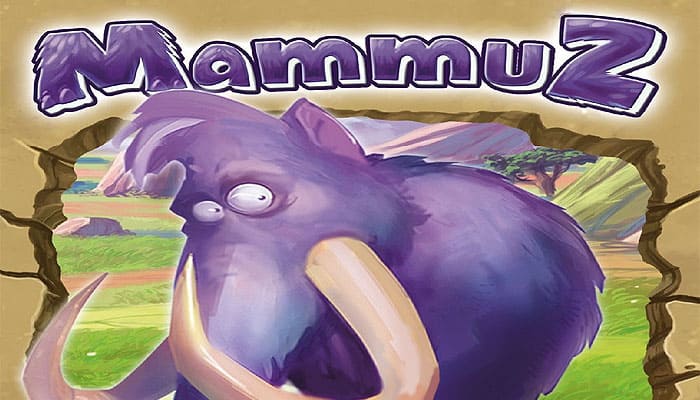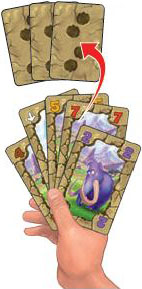
Welcome to the ice age, to pursue your search for squirrels, saber-toothed tigers, mammoths and dinosaurs. What? You're saying there are no dinosaurs anymore?
You're wrong! Even though many species die out over the course of this game, the dinosaurs will survive. MammuZ is a card game for 3 to 7 players, 8 years and up, in which cheating is officially allowed.
Game Materials

- 2 mammoth cards
- 3 bear cards
- 4 deer cards
- 5 saber-toothed tiger cards
- 6 hare cards
- 7 squirrel cards
- 8 gopher cards
- 9 mouse cards
- overview cards
- 6 dinosaur cards
Object of the Game
Your objective is to be the first to get rid of all your hand cards. You can do this by either laying out cards - where you may cheat to your heart's content - or discarding complete species.
Setup
| #players | Animals cards to be removed | Dinosaurs in play | Cards in play | Hand cards per player |
|---|---|---|---|---|
| 3 | Mice and gophers | 3 | 30 | 10 |
| 4 | Mice | 5 | 40 | 10 |
| 5 | Mice | 5 | 40 | 8 |
| 6 | - | 4 | 48 | 8 |
| 7 | - | 5 | 49 | 7 |
Depending on the number of players, all animal cards of the species listed in the table above are removed from the game.
Shuffle the 6 dinosaur cards and randomly draw the number of cards according to the number of players. The dinosaur cards that are not needed are removed from the game.
After that, shuffle all cards remaining in play and deal them out evenly to the players.
Put the overview cards of the species in play next to one another in the middle of the table, with the colored side facing up.
Game Play
Beginning a round
The last player to see a dinosaur becomes the starting player and begins the first round. He declares one species for this round and places 1 to 4 cards face down in front of him.
This is his current display, which he uses to begin a herd. He claims that he has played animal cards of this species only. But in fact, his display might be composed of different animals. Cheating is allowed.

Example: Player 1 claims: "These are two saber- toothed tigers".
Then the other players follow in clockwise order. When somebody has his turn, he is the active player. He can now either expand the herd or challenge the previous display.
A. Expanding the herd
If the active player believes the previous player, he puts 1 to 4 cards as his current display face down in front of him on the table. He announces the number of cards he has played and repeats the species declared for this round.

Example 2 Player 2 claims: "I have here three more saber-toothed tigers".
Then the next player in clockwise order follows; he can also either expand the herd or challenge the previous display.
Important: A herd contains all cards played in a round.
Attention: The number of cards in a herd can be higher than the actual number of animal cards of the respective species. This is a sign that at least one player has already cheated.
B. Challenging the previous display
If the active player distrusts the previous player's claim, he checks that player's current display. To this end, he chooses any one card of that display and reveals it. Three cases can occur:
-
The active player has challenged unjustly.

If the card matches the species that has been declared as a herd for this round, the active player has to take the entire herd into his hand.
After that, the player who follows the active player in clockwise order begins a new round with a new herd.
-
The active player has challenged correctly.

If the card does not match the species that has been declared as a herd for this round, the player who went previously has to take the entire herd into his hand. After that, the active player begins a new round with a new herd.
The revealed card shows a dinosaur.

If the card is a dinosaur, the applicable action is carried out (see below). After that, the active player takes the dinosaur into his hand and begins a new round with a new herd.

Brontosaurus
The player who went previously has to take the entire herd into his hand.

Pterosaurus
The active player has to take the entire herd into his hand.

Triceratops
The active player chooses a player who has to take the entire herd into his hand.
Stegosaurus

The active player shuffles the entire herd. He deals the cards, one after another, to all players, beginning with the player on his left. After that, each player takes the card(s) into his hand.
Plesiosaurus

Without looking at the herd, players put together all the herd cards in a pile in the middle of the table. The active player
begins a new herd with a new species. When somebody has to pick up the new herd as the game continues, he has to take the old herd into his hand in addition.

Tyrannosaurus Rex
The entire herd of this round is removed from the game. All cards of this herd are sorted by species and put face up underneath the corresponding overview card(s).
Special case: From now on, only the remaining amount of cards of the applicable species is required for it to "die out" (see Becoming extinct).
Becoming Extinct
If, at any time during the game, a player has all cards of a species in his hand, he shows them and immediately puts them on the corresponding overview card.
Then he turns the pile over so that the brown back of the overview card is visible. This species has now become extinct and, consequently, is out of the game. (Attention: see special case Tyrannosaurus rex).
 Overview cards with the extinct bear and saber-toothed tiger |
Attention: The dinosaurs never become extinct, not even if a player has all dinosaurs in his hand.
Important: If somebody has several turns during a round, he moves his old display slightly up, for a better overview, and places his new cards as his current display below it. Only the current display can be challenged.

End of the Game
When somebody lays out his last hand cards in front of him, players check whether the game ends. The next player must challenge this display. The following three cases can occur:
-
If the revealed card shows the species declared, the game ends immediately and the respective player wins.
-
If the revealed card does not show the species declared, the respective player has to take the entire herd into his hand and the game continues.
-
If the revealed card shows a dinosaur, the action of this dinosaur is carried out. If, after that, the respective player still has no cards in his hand, he wins the game.
The game also ends if one player discards his last hand cards due to the "extinction" of a species. In this case, he wins immediately.
Continue Reading

